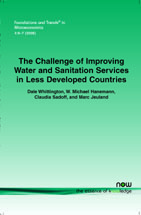The Challenge of Improving Water and Sanitation Services in Less Developed Countries
By Dale Whittington, Department of Environmental Sciences & Engineering, University of North Carolina, USA and Manchester Business School, Manchester University, UK, Dale_Whittington@unc.edu | W. Michael Hanemann, Department of Agricultural and Resource Economics, University of California at Berkeley, USA | Claudia Sadoff, The World Bank, Nepal | Marc Jeuland, Department of Environmental Sciences & Engineering, University of North Carolina, USA
Abstract
This paper argues that there are many challenges to designing and implementing water and sanitation interventions that actually deliver economic benefits to the households in developing countries. Perhaps most critical to successful water and sanitation investments is to discover and implement forms of service and payment mechanisms that will render the improvements worthwhile for those who must pay for them. In this paper, we argue that, in many cases, the conventional network technologies of water supply and sanitation will fail this test, and that poor households need alternative, non-network technologies. However, it will not necessarily be the case that specific non-network improved water supply and/or sanitation technologies will always be seen as worthwhile by those who must pay for them. We argue that there is no easy panacea to resolve this situation. For any intervention, the outcome is likely to be context-dependent. An intervention that works well in one locality may fail miserably in another. For any given technology, the outcome will depend on economic and social conditions, including how it is implemented, by whom, and often on the extent to which complementary behavioral, institutional and organizational changes also occur. For this reason, we warn against excessive generalization: one cannot, in our view, say that one intervention yields a rate of return of x% while another yields a return of y%, because the economic returns are likely to vary with local circumstances. More important is to identify the circumstances under which an intervention is more or less likely to succeed. Also for this reason, when we analyze a few selected water and sanitation interventions, we employ a probabilistic rather than a deterministic analysis to emphasize that real world outcomes are likely to vary substantially.
The Challenge of Improving Water and Sanitation Services in Less Developed Countries
The Challenge of Improving Water and Sanitation Services in Less Developed Countries shows the key to successful water and sanitation investments is to discover forms of service and payment mechanisms that will render the improvements worthwhile for those who must pay for them. However for any investment, the outcome is likely to be context-dependent – the outcome depends on economic and social conditions, including how it is implemented, by whom, and to what extent complementary changes - in behavior, in institutions, and sometimes in economic organization - also occur. The Challenge of Improving Water and Sanitation Services in Less Developed Countries is organized in three parts. Part I focuses on conventional network technologies for water supply and sanitation. Part II presents the probabilistic analytical approach that we use to analyze investments in the water and sanitation sector. In Part III we deploy this analytical framework to examine the costs and benefits of three specific low-cost, non-network water and sanitation interventions (deep boreholes with public handpumps, total community-led sanitation campaigns, and biosand filters) and one high-cost intervention (large multipurpose dams in Africa).
